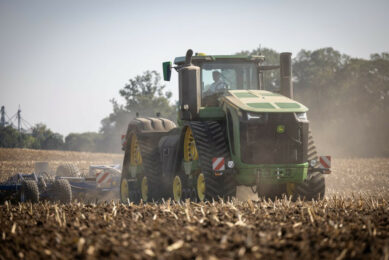John Deere Autotrac Vision for tractors and sprayers

Autotrac Vision uses a hi-res front-mounted camera to automatically guide machinery down established crop rows.
John Deere has launched its new AutoTrac Vision system for selected tractor and self-propelled sprayer models. This uses a high resolution front-mounted camera to automatically guide machinery down established crop rows, and effectively provides guidance without the need for guidance lines.
‘Big step forward in precision agriculture’
“AutoTrac Vision allows users to bring more technology and automation to operations that are still driven manually. We see this being a big step forward in precision agriculture, to help producers enhance their equipment performance, improve machine uptime and reduce operating costs,” says John Deere Limited AMS product sales specialist Jack Howard.
The system uses a camera combined with GPS technology to guide the tractor or sprayer down either tramlines or crop rows. John Deere says it allows operators to work faster, with less stress, at speeds of up to 30kph. It can also be used to guide implements, such as an inter-row tiller.
Text continues underneath image
Hybrid steering system
AutoTrac Vision’s hybrid steering system optimises machinery operation in early-season grain or maize crops by continuously merging two data streams, a GPS correctional signal and the available image data recorded by the onboard camera system. This means users can benefit from automated steering in fields that have been planted without a guidance system, or where an existing guidance line is unavailable.
The camera detects the tramline or plant row and steers the machine along it, keeping the vehicle wheels in the centre between rows to reduce crop damage and help increase yields. In situations where it can’t detect a row, the system will fall back to an auto-generated guidance line.
Text continues underneath video
AutoTrac Vision can see and detect early season row crops
According to John Deere, this fusion of a camera image and auto-generated A-B lines ensures that even in spots where the camera is unable to detect distinctive crop rows, you can rely on the system to guide the machine. AutoTrac Vision can see and detect early season row crops as long as the camera can differentiate between the crop rows and the soil – for example, working with a slurry tanker in early season maize, as soon as the plants are at least 10cm high.
Text continues underneath image
“Even if the operator starts to tire after a long day in the field for example, the system will maintain the required speed and performance levels. Not only does it allow up to 20 per cent more crop area to be covered per day, it will also work at night,” says John Deere.
Currently AutoTrac Vision can be retrofitted for around $ 3,500 to 6M, 6R (not including models fitted with a panoramic glass roof), 7R and 8R/8RT Series tractors plus R Series self-propelled sprayers.
Join 17,000+ subscribers
Subscribe to our newsletter to stay updated about all the need-to-know content in the agricultural sector, two times a week.



